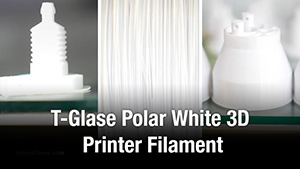taulman3D has been on a roll lately, releasing new 3D printing materials on a continuous basis this year. The latest, dubbed t-glase Polar White, was co-developed by Mike Adams, the founder of FoodRising.org, and is meant to be stronger than previous t-glase materials from taulman and offer a nice, snow-white appearance.

In contrast to taulman’s previous t-glase, Polar White is opaque and stronger, with great structural integrity and layer-to-layer adhesion. The material also flows well at low extruder temperatures, leading to prints with minimal shrinkage and high durability. I reached out to taulman’s Tom Martzall to learn more about the process behind this material’s development. It turns out that, by making the material white, the incorporation of PET into the filament increased its tensile strength:
White t-glase is about 10% stronger overall, as compared to Clear t-glase, bringing it up to 5,300 PSI Tensile when 3D Printed. This is in tensile strength only. Elongation remains the same at 7.4%. The added strength is derived from the fact that, as an opaque line, the standard t-glase optical clarity is not a requirement. This allows us to adjust the chemistry a bit. Next, is the white colorants. In order to meet the customer’s requirements, we had to go beyond the standard and add an additional colorant. Because PET is one of the polymers that the additional colorant binds to extremely well, the result is an increase in 3D printed Tensile strength. White is a difficult color to match to the customer’s requirements. The major benefit, is that 3D Printed parts are not only a true white, but they have a highly reflective glass-white appearance, as well. The technique is not new and used often when industry makes PET packaging, yet, rather than black nomenclature, they use a similar process to provide the printing in white, making the writing on the package impossible to remove.
Tom also tells me that, in developing new filaments, working with his clients is often essential:
…Food Rising was instrumental in its development, as we [at taulman3D] have other colors we’re looking into, but all are translucent. White t-glase is the only opaque t-glase. Even our “black” is a smoked glass transparent. An important note: At taulman3D, we are not an “invented here” company. While most polymers are invented here, we try to work with industrial and commercial customers on special projects. As an example, we have a medical grade EVA material we [develop] with special customers. We also have a super-high Tg material that we provide to Automotive Antique shops to print tail lights and other lens covers, as it can handle extreme temps and is clear. Some, like White t-glase will transition to our site, while others may only have a very narrow use and become specialty lines.
I consider taulman3D, like Kai Parthy, to be among the pioneers of 3D printing materials, consistently exploring new filaments and refining existing ones. If t-glase Polar White is good enough for a self-watering hydroponics device, then it might just be good enough for your 3D printing application. And there will be plenty more where it came from.


